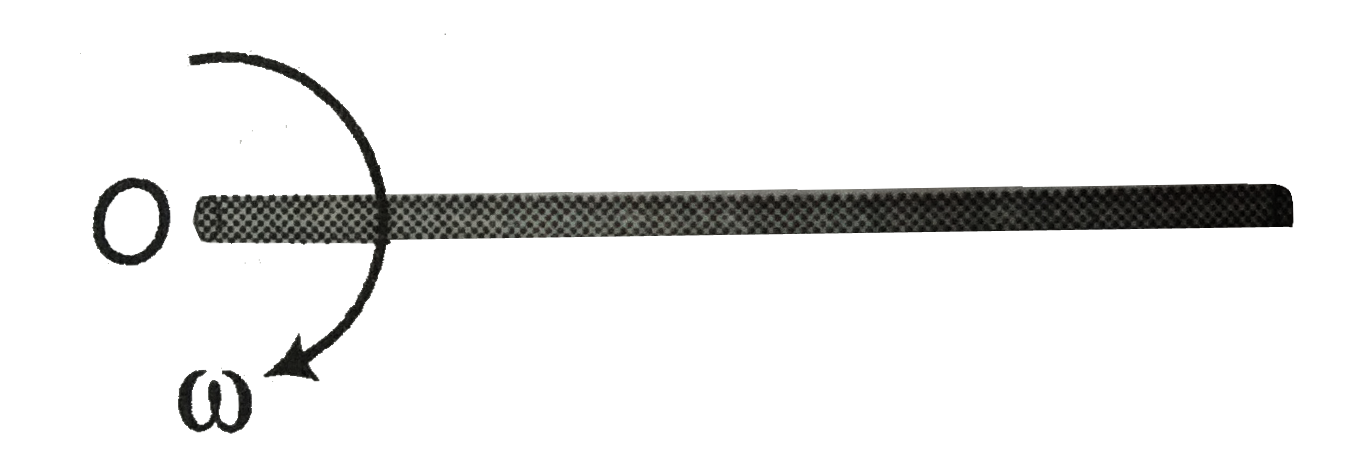A mass of 10 kg connected at the end of a rod of negligible mass is rotating in a circle of radius 30 cm with an angular velocity of 10 rad/s. If this mass is brought to rest in 10 s by a brake, what is the magnitude of the torque applied ?
0.9 N-m
1.2 N-m
2.3 N-m
0.5 N-m
The correct Answer is:A
To solve the problem step by step, we will follow the outlined procedure:
Step 1: Identify the given values
- Mass (m) = 10 kg
- Radius (R) = 30 cm = 0.3 m
- Initial angular velocity (ω₀) = 10 rad/s
- Final angular velocity (ω) = 0 rad/s (since the mass is brought to rest)
- Time (T) = 10 s
Step 2: Calculate the angular acceleration (α)
We can use the formula for angular velocity:
ω=ω0+αT
Substituting the known values:
0=10+α⋅10
Rearranging gives:
α⋅10=−10⟹α=−1 rad/s2
Step 3: Calculate the moment of inertia (I)
The moment of inertia for a point mass rotating about an axis is given by:
I=mR2
Substituting the values:
I=10⋅(0.3)2=10⋅0.09=0.9 kg m2
Step 4: Calculate the torque (τ)
Using the relationship between torque, moment of inertia, and angular acceleration:
τ=Iα
Substituting the values we calculated:
τ=0.9⋅(−1)=−0.9 N m
Step 5: Determine the magnitude of the torque
Since we are interested in the magnitude of the torque, we take the absolute value:
|τ|=0.9 N m
Final Answer
The magnitude of the torque applied is 0.9 N m.
---
- Mass (m) = 10 kg
- Radius (R) = 30 cm = 0.3 m
- Initial angular velocity (ω₀) = 10 rad/s
- Final angular velocity (ω) = 0 rad/s (since the mass is brought to rest)
- Time (T) = 10 s
We can use the formula for angular velocity:
ω=ω0+αT
Substituting the known values:
0=10+α⋅10
Rearranging gives:
α⋅10=−10⟹α=−1 rad/s2
The moment of inertia for a point mass rotating about an axis is given by:
I=mR2
Substituting the values:
I=10⋅(0.3)2=10⋅0.09=0.9 kg m2
Using the relationship between torque, moment of inertia, and angular acceleration:
τ=Iα
Substituting the values we calculated:
τ=0.9⋅(−1)=−0.9 N m
Since we are interested in the magnitude of the torque, we take the absolute value:
|τ|=0.9 N m
The magnitude of the torque applied is 0.9 N m.
Topper's Solved these Questions
- BOOK - DC PANDEY ENGLISHCHAPTER - ROTATIONEXERCISE - Check point 9.315videos
ROTATION
- BOOK - DC PANDEY ENGLISHCHAPTER - ROTATIONEXERCISE - (A) Chapter Exercises83videos
ROTATION
- BOOK - DC PANDEY ENGLISHCHAPTER - ROTATIONEXERCISE - Check point 9.120videos
ROTATION
- BOOK - DC PANDEY ENGLISHCHAPTER - RAY OPTICSEXERCISE - Integer type q.14videos
RAY OPTICS
- BOOK - DC PANDEY ENGLISHCHAPTER - ROTATIONAL MECHANICSEXERCISE - Subjective Questions2videos
ROTATIONAL MECHANICS
Similar Questions
If 2 kg mass is rotating on a circular path of radius 0.8 m with angular velocity of 44 rad/sec. If radius of the parth becomes 1 m, then what will be the value of angular velocity?
View SolutionA article moves in a circle of radius 20 cm with linear speed of 10 m/s. Find the angular velocity
View SolutionA body is whirled in a horizontal circle of radius 20cm. It has an angular velocity of 10rad/s. What is its linear velocity at any point on the circular path
View SolutionA ring of radius 0.5 m and mass 10 kg is rotating about its diameter with angular velocity of 20rads−1. Its kinetic energy is
View SolutionStone of mass 1 kg tied to the end of a string of length 1m , is whirled in horizontal circle with a uniform angular velocity 2rads−1. The tension of the string is (in newton)
View SolutionA body of mass 1 kg is rotated in a horizontal circle of radius 1 m and moves with velocity 2ms−1 The work done in 10 revolutions is
View Solution
A rod of mass 2 kg ad length 2 m is rotating about its one end O with an angular velocity ω=4rad/s. Find angular momentum of the rod about the axis rotation.View SolutionA dumb bell consists of two identicasl small balls offmss 1/2 kg each connected to the ends of a 50 cm long light rod. The dumb bell is rotating about a fixed axis through the centre of the rod and perpendicular to it t an angular speed of 10 rad/s. An impulsive force of average magnitude 5.0 N acts on one of the masses in the direction of its velocity for 0.10s. Find the new angular velocity of the system.
View SolutionA spring of force constant 1200Nm−1 is mounted on a horizontal table and a mass of 3.0 kg of attached to the free and of the spring. The mass is made to rotate with an angular velocity of 10 rad/s. What is the elongation produced in the spring if its unstretched length is 60 cm ?
View SolutionA disc of mass 1 kg and radius 0.1 m is rotating with angular velocity 20 rad/s. What is angular velocity (in rad/s) if a mass of 0.5 kg is put on the circumference of the disc ?
View Solution

